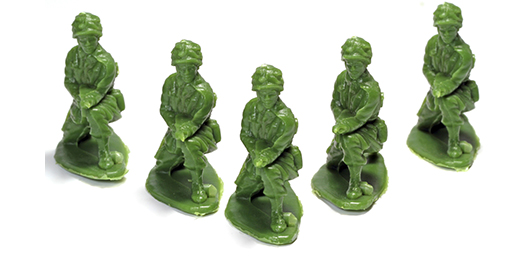Succession Squads: An Innovative Approach for Developing High-Potential Talent
By Natalie Michael, CHRP
Let’s face it, developing people’s potential is easier said than done. Who hasn’t promoted someone with fantastic potential only to have them falter and “not work out?”
Like you, I am always looking for new ways to develop others so that the time and energy I put towards coaching and mentoring pays off. The latest tool in my toolbox? Succession squads.
The idea for succession squads came to me after watching the movie American Sniper and noticing how the soldiers work together. Historically, a “squad” in the US army was a sub-unit of four to 12 people that was put in place to prepare sergeants for special assignments, and to run them through drills that would prepare them for battle. The squads were specially designed to take into account the circumstances the solider would find themselves in, and would often include representatives from different segments of the army. As such, the squads were proactively designed, highly trained, and useful to the sergeant preparing for a progressively more challenging assignment.
This got me thinking about the similarities in a succession program – minus the war zone hopefully — wherein leaders are asked to participate in progressively more complex challenges. Why not be more intentional about putting in place a squad to support leaders?
How to Proactively Appoint a Succession Squad
Here is how it works. After I determine someone has potential, we sit down together to proactively identify their squad: six to eight people who will help them succeed and achieve what is important for their career. Once established, we use the SET formula (Strategy, Emotions and Task support) to target our efforts.
S = Strategy: Ultimately, developing potential is about possibilities for the future. To figure out the strategic members of the succession squad start by figuring out what kind of strategic contribution the leader wants to make and then determine who can best help them. Coaching questions may be:
- What difference do you want to make over the next 5 years?
- What is the opportunity you are going after?
- Why is this important to you?
- What are the risks or obstacles you will need to overcome?
- What are the tough calls you will need to make?
- Who are the best people to strategically support you?
E = Emotional: Let’s face it, human beings are emotional and when leaders are stressed or bored they tend to behave strangely—meaning they are not in alignment with their “best self” and highest intentions. Helping high-potential leaders identify their emotional triggers and put an emotional management plan in place is highly valuable as it helps them to balance the head and heart. Coaching questions are:
- What are the emotions that tend to distract from your success? (i.e. boredom, stress, anxiety, pressure,rejection, insecurity)
- Who inspires you to stay on track and reach for your goals?
- When you consider the future, where do you feel least confident in your ability?
- Who are the people who can help you shift your perspective when you need a boost? Or help bring you back to equilibrium when you are out of balance?
Note: Many leaders put their spouse as their top emotional support. I recommend going beyond this because when works get really stressful the spouse often has limited capacity to help day in and day out.
T = Task: This third category is the one that leaders usually find the easiest to put in place, although not always. The task squad members are the people who help the leader to get things done. For example, if a leader wants to build the company brand, a key task squad member may be a branding consultant; if they want to change the culture, it may be an HR executive. Questions are:
- What do you need to get done to achieve your vision?
- Of your top priorities, where do you have the lowest skill or capability?
- Where do you have the lowest motivation?
- Where is time not on your side?
- Who can you call on to give you advice about how to best approach key tasks?
In the end succession squads are a key part of developing high potential leaders. They help leaders to navigate the future with greater wisdom, clarity, and focus, and they can give them a confidence boost just when they need it.
Also, one client said to me: “Now I know who to network with, so I don’t feel so guilty that I am not doing enough of it.” Bonus!
Natalie Michael and Michael Timms are presenting at HRMA’s 2016 Conference + Tradeshow. Their session, Succession Planning That Works, is on Wednesday, April 27. For more information on this and other sessions, please visit hrma.ca/conf2016.
Natalie Michael, CHRP is a CEO and executive coach with The Karmichael Group and a MacKay CEO Forums chair. She coaches executives who want to extract more meaning from their work, refine their leadership style and be more influential in challenges (and sometimes political) environments.









